
“Bonac Blind,” artist Scott Bluedorn’s floating dwelling created with handmade and found materials, is currently moored off Landing Lane, Springs, East Hampton and will remain open to visitors through November 8 and possibly beyond. Originally, the structure was slated to be on view from October 17 to 23.
The “Bonac Blind” is presented as part of the 2020 Parrish Road Show, the museum’s creative off-site exhibition series that connects art to life in the region by featuring temporary projects by East End artists. The art installation, an interpretation of duck blinds used for camouflage by local hunters, addresses the affordable housing crisis and the gradual disappearance of Bonac culture on the East End.
Bluedorn, who lives in East Hampton, will offer guided visits of the structure on Tuesdays and Thursdays from 2 to 5 p.m. and Saturdays noon to 3 p.m. or by appointment through scottbluedorn@gmail.com. Though the piece was recently targeted by vandals, it has been repaired and remains on site.
According to Bluedorn, who participated in the Parrish’s 2019 Artists Choose Artists exhibition, “The ‘Bonac Blind’ is a multi-faceted art intervention: A floating, off-grid microhome that references traditional Bonac culture of fishing, farming and hunting, while also serving as a comment on the erosion of this culture due to the compound problems of housing crisis, climate change and modernity.”
Constructed from a repurposed, plywood duck blind and covered in native reed, the structure features industrial barrels, resin windows, and a geodesic dome. According to the artist, the name is a double entendre, obviously referring to duck blind used during waterfowl season. But the title also points to the area’s current population, largely blind to Bonac culture and the many problems it faces. Bluedorn’s intention is to raise awareness to the drastic shortage of affordable housing in the Hamptons that has effected a mass exodus of working-class people, particularly in the generations of East Hampton families known as Bonackers or Bubs, who farmed, fished, and hunted for their livelihood or as tradition. This population is increasingly leaving the area for more affordable regions, taking with them character, history, culture, and tradition.
An intentionally ironic solution to housing, the “Bonac Blind” proposes that a camouflage shed can be remade into a tiny and affordable floating house, complete with off-grid amenities such as solar panels, solar batteries, a simple bed, plumbing, and a hot plate. While alluding to traditional Bonac culture of hunting and austere living in the natural environment, the “Bonac Blind” will be fully functional and decorated with original artwork. The project also references the current trend of tiny homes that are sustainable, resilient, and adaptive — as well as the desire to separate oneself (physically and hermetically) from the “wealthy elite” culture of the Hamptons.
An artist, illustrator, and designer, Bluedorn works in various media, including painting, drawing, print process, collage and found object assemblage. Drawing inspiration from cultural anthropology, primitivism, and nautical tradition, Bluedorn distills imagery that speaks to the collective unconscious, especially through myth and visual story-telling — a world he conjures as “maritime cosmology.” Bluedorn received his BFA from the School of Visual Arts, New York. His work is on view at The Edward Albee Foundation in New York City, and is included in numerous private collections in the United States, Canada, Ireland, France, and Portugal.